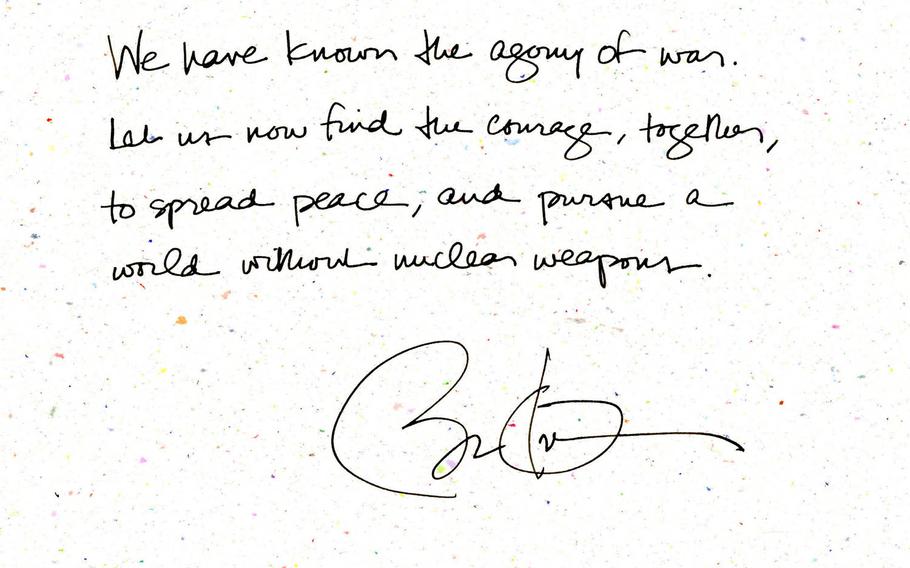
Paper cranes donated by President Barack Obama to the Hiroshima Peace Memorial Museum during his history-making visit earlier this year are scheduled to go on loan to the Nagasaki Atomic Bomb Museum in the fall, Hiroshima officials announced this week. They will be on display along with a reproduction of the message President Obama wrote in the visitor's book at the Hiroshima museum. (Hiroshima Peace Memorial Museum)
Origami cranes that President Barack Obama folded and donated to the Hiroshima Peace Memorial Museum during his history-making visit are being loaned to the Nagasaki Atomic Bomb Museum.
Two of the four cranes, now on display in Hiroshima, will arrive in Nagasaki in September, said Katsumi Suesada, a spokesman for Hiroshima city government’s peace promotion division. They will be on display for three months along with a reproduction of the message Obama wrote in the visitors’ book at the Hiroshima museum in May.
Paper cranes carry a special significance to the people of Hiroshima and Nagasaki, especially with survivors of the atomic bomb blasts on Aug. 6 and 9, 1945. The bombs brought an end to World War II but also claimed more than 200,000 lives, mostly civilians.
“Paper cranes symbolize people’s prayers for peace.” Suesada said. “The paper cranes folded by President Obama, the first sitting U.S. president to visit Hiroshima, are very precious. Displaying the paper cranes in Nagasaki is a means for us to renew the shared commitment of the two cities to continue our joint effort to abolish nuclear weapons from the world.”
The agreement on loaning the cranes was made last week after overtures from Hiroshima Mayor Kazumi Matsui to Nagasaki Mayor Tomihisa Taue, Suesada said. Details of when and where to display them are being worked out, Nagasaki officials said.
The cranes will next travel to Chicago as part of the Hiroshima-Nagasaki A-bomb Exhibition scheduled to start Oct. 1 before being retired for a while “to protect them from fading and deterioration,” Suesada said.
Suesada said it was coincidence that the annual overseas exhibition, jointly sponsored by Hiroshima and Nagasaki since 1995, is being held this year in Chicago, where Obama’s political career began.
Since the cranes were put on display in Hiroshima shortly after the president’s visit, the number of visitors to the museum surged by 40 percent, museum officials told Stars and Stripes. Approximately 1.5 million people visited the Hiroshima museum last year.
Paper cranes became a special symbol to the survivors of the blasts and to residents of the two cities thanks in large part to Hiroshima survivor Sadako Sasaki. The 12-year-old girl received 1,000 folded paper cranes as a get-well gift while she battled leukemia in a Hiroshima hospital 10 years after the bombing. Sasaki was inspired by the gift and began making cranes herself with the traditional belief that folding 1,000 of them would make her get-well wish come true. She died eight months later before reaching her goal.
A statue of the young girl holding a crane — called the Children’s Peace Monument — was dedicated in the central area of the Hiroshima Peace Park to the children who died of radiation sickness from the atomic bomb.